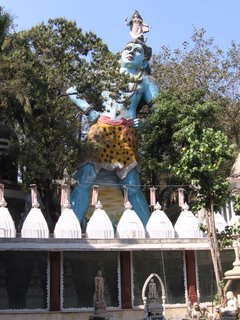
Yesterday we went through Survoday Hospital. Meaning "Good For All" or "Prosperity For All", Survoday is a free hospital to the community and offers special services to people with HIV and tuberculosis. In addition to providing the community with healthcare, a hindu temple, buddhist shrines, a mosque and a christian chapel are all on hospital grounds. We started the day by visiting these various religious sections and were oriented a bit on Hinduism. The statues were impressive and it was interesting to see this aspect of Indian life at a closer level. More than anything what impressed me about this facet of the hospital were their efforts to accomadate everyones religious practices. In a country where tension runs high between two of the world’s major religions, it was refreshing to see that strides are being made to ensure harmony, especially in a location were faith is so necessary.
Although tuberculosis is present in the United States, it represents a minor public concern. The american cities where it can be found are the poorest sections of the country where population densities are high and the quality of life is low. Just as in the U.S., tuberculosis afflicts the poor sections of Mumbai—which are a large portion of the city. I don’t want to depict Bombay as being a city filled with the diseased spreading TB everywhere; the city is spectacular, but it does have public health challenges particular to its situation. HIV is also a concern and with around 11% of tuberculosis patients being HIV positive, and with HIV patients having a 60% chance of contracting TB at some time in their lives, the two diseases combine to form a deadly alliance. To further complicate matters rifampicin, an antibiotic of choice here against TB, inhibits certain antiretrovirals.
 The government has implemented measures which have helped to decrease the numbers of people that are infected with either disease, especially in indigent areas. However, the program isn’t perfect and there are some challenges associated with its application. People infected with HIV who are in need can receive healthcare and medication at no cost upon proving their economic position and permanent residence in the area corresponding to the hospital. The reason for the proof of residence is because the program is similar to the TB DOTS program, directly observed short-course chemotherapy, where the patient is dispensed the medication at the proper time by the healthcare provider. This is to ensure medication is taken properly. One of the problems is that one of the high-risk groups in Mumbai is the migratory workers. They move from place to place as day laborers scraping together an income. Truck-drivers fall into this category as well as their work carries them to all ends of the country. Directly observed therapy becomes out of reach and along with it the healthcare needed by these people.
The government has implemented measures which have helped to decrease the numbers of people that are infected with either disease, especially in indigent areas. However, the program isn’t perfect and there are some challenges associated with its application. People infected with HIV who are in need can receive healthcare and medication at no cost upon proving their economic position and permanent residence in the area corresponding to the hospital. The reason for the proof of residence is because the program is similar to the TB DOTS program, directly observed short-course chemotherapy, where the patient is dispensed the medication at the proper time by the healthcare provider. This is to ensure medication is taken properly. One of the problems is that one of the high-risk groups in Mumbai is the migratory workers. They move from place to place as day laborers scraping together an income. Truck-drivers fall into this category as well as their work carries them to all ends of the country. Directly observed therapy becomes out of reach and along with it the healthcare needed by these people. Other problems exist as well. Antiretroviral drugs carry side-effects and patients sometimes become noncomplient. Rather than notify the doctor, they simply accept their medications but stop taking them. They do this out of fear of being denied healthcare if they report their complications. Perhaps they have the hopes of restarting medication later, or maybe they feel the healthcare they receive is enough without the medication. They come to the doctors then wanting treatment for their symptons without dealing with the cause.
Other problems exist as well. Antiretroviral drugs carry side-effects and patients sometimes become noncomplient. Rather than notify the doctor, they simply accept their medications but stop taking them. They do this out of fear of being denied healthcare if they report their complications. Perhaps they have the hopes of restarting medication later, or maybe they feel the healthcare they receive is enough without the medication. They come to the doctors then wanting treatment for their symptons without dealing with the cause.Another group particularly in danger of becoming infected with HIV is housewives. It seems too many husbands fail to disclose to their spouses that they are positive. Many marriages are arranged and sometimes this occurs with the person’s family keeping the secret from the other.
When I asked the doctor in charge of the AIDS ward what the largest problem was in India regarding the treatment of these patients as well as people living with HIV he said something quite interesting. "The biggest problem is the same as in other countries—apathy of the educated class. The upper and middle class don’t want to bother with the disease until it reaches their own neck."


0 Comments:
Post a Comment
<< Home